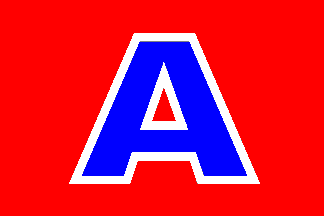 image by Jarig Bakker, 29 Dec 2004
image by Jarig Bakker, 29 Dec 2004
Last modified: 2017-11-11 by bruce berry
Keywords: south africa | houseflags | african coasters | aliwal | celphalonia | durban coasters | grincor | irvin & johnson | point shipping | safmarine | sal | smith's coasters | thesen's steamship | tristan development corp | unicorn li |
Links: FOTW homepage |
search |
disclaimer and copyright |
write us |
mirrors
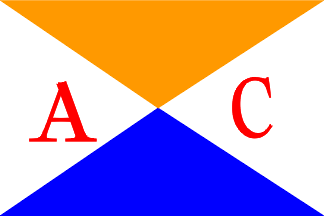 image by Jarig Bakker, 05 Jan 2005
image by Jarig Bakker, 05 Jan 2005
From Scott, R.M., The Caltex Book of Flags and Funnels, Cape Town,
Caltex Africa Ltd. (1959) [scx59].
#136 African Coasters (Pty.) Ltd., Durban - quartered per saltire orange - white
- blue - white; on white red "AC".
Jarig Bakker, 05 Jan 2005
This version is also shown by US Navy 1961 and Stewart 1963 whereas Brown
1951 changed the orange quarter to yellow and had black letters.
Neale Rosanoski, 28 Feb 2005
 image by Jarig Bakker, 29 Dec 2004
image by Jarig Bakker, 29 Dec 2004
From Scott, R.M., The Caltex Book of Flags and Funnels, Cape Town, Caltex Africa Ltd. (1959)
[scx59].
#37 Aliwal Steamship Co., Cape Town (Panama flag) - red flag, blue "A" contoured white
Aliwal is a town in the Punjab, India. Aliwal North is a town in the Free State
province of South Africa, southwest of Lesotho.
Jarig Bakker, 29 Dec 2004
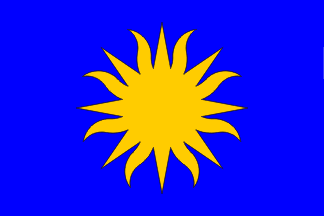 image by
Martin Grieve, 31 Mar 2005
image by
Martin Grieve, 31 Mar 2005
Cephalonia Shipping (Pty) Ltd registered a flag with the South African Bureau of
Heraldry on 18 April 1975 with the description: On a rectangular flag Azure, a sun in
splendor
Or.
Source: Data
of the Bureau of Heraldry on registered heraldic representations.
Mark Sensen, 19 May 2002
According to Lloyds and ship details, the reference to Durban
Coasters is not an error with Durban Coasters (Pty) Ltd. appearing to have
commenced operations in 1956 and then changing name in 1961 to Durban Lines
(Pty) Ltd. I have nothing on their original ownership but Grindrod apparently
bought a 30% interest, possibly through their subsidiary Unicorn Lines (Pty) Ltd
in 1970, and then full ownership in 1974 which predates the collapse of the
Mosenthal Group.
However, I do have issue with the two flags currently being shown in FOTW. The
straight rectangular version by Martin, with no specific source otherwise given,
presumably results from the post by Syd Oram. However he comments that "The
Durban Lines house flag is correctly depicted in your website" and this
presumably refers to the image by Jarig which however shows a swallowtail.
Jarig's source itself seems suspect in showing a Scandinavian-style cross.
US Navy 1961 with a slightly narrower cross has its fesse point midway between
hoist and fork [see image below] which is supported, although the fork may have
been more shallow, by flag images shown on an ashtray at
www.liveauctioneers.com/item/5156492 [which also shows a flag for
agents King & Sons, Gunn & Co. (Pty) Ltd.].
Neale Rosanoski, 31 May 2011
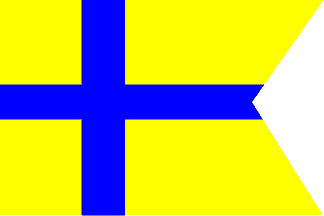 image by
Jarig Bakker, 02 Jan 2005
image by
Jarig Bakker, 02 Jan 2005
From Scott, R.M., The Caltex Book of Flags and Funnels, Cape Town, Caltex
Africa Ltd. (1959) [scx59].
#60 Durban Coasters Ltd., Durban - yellow swallow tail background with blue
Scandinavian-style cross.
Jarig Bakker, 02 Jan 2005
According to Lloyds and ship details, the Durban Coasters (Pty) Ltd appears to
have commenced operations in 1956 and then changing name in 1961 to
Durban Lines (Pty) Ltd. I have nothing on their original
ownership but Grindrod apparently bought a 30% interest, possibly through their
subsidiary Unicorn Lines (Pty) Ltd, in 1970 and then full ownership in 1974
which predates the collapse of the Mosenthal Group.
However I do have issue with the two flags currently being shown in FOTW.
The straight rectangular version by Martin, with no specific source otherwise
given, presumably results from the post by Syd Oram. However he
comments that "The Durban Lines house flag is correctly depicted in your
website" and this presumably refers to the image by Jarig which however shows a
swallowtail.
 image sent by Neale Rosanoski, 31 May 2011
image sent by Neale Rosanoski, 31 May 2011
Jarig's source itself seems suspect in showing a Scandinavian-style cross. US
Navy 1961 with a slightly narrower cross has its fesse point midway between
hoist and fork (see image above) which is supported, although the fork may have
been more shallow, by flag images shown on an ashtray at
www.liveauctioneers.com/item/5156492 [which also shows a flag for agents
King & Sons, Gunn & Co. (Pty) Ltd.].
Neale Rosanoski, 31 May 2011
![[Grincor houseflag]](../images/z/za~grinc.gif) image by Jorge Candeias, 12 Feb 1999
image by Jorge Candeias, 12 Feb 1999
A triangular red flag with a bold italic "G" in white.
Jorge Candeias, 12 Feb 1999
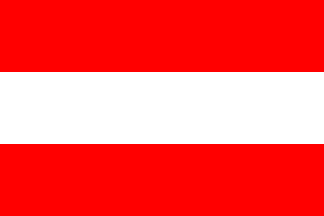 image by Jarig Bakker, 30 Dec 2004
image by Jarig Bakker, 30 Dec 2004
From Scott, R.M., The Caltex Book of Flags and Funnels, Cape Town, Caltex Africa Ltd. (1959)
[scx59].
#48 Irvin & Johnson, Cape Town - horizontal triband of Red, White and Red.
Jarig Bakker, 30 Dec 2004
André Burgers of Cape Town writes:
I&J is a deep sea fishing company and I am not sure it belongs here. At the start of
World War II, South Africa had no navy and a sea service called the Seaward Defence Force (SDF) was hurriedly created from which the modern
SA Navy traces its origins. This force's primary purpose was
minesweeping and anti-submarine work around the South African coast (although they
later also served in the Mediterranean). Most of the vessels came from
requisitioned
trawlers from the local fishing (and whaling) companies of which Irvin and Johnson was one of the biggest and contributed the most vessels.
The Nazi propaganda radio station operating from the occupied Netherlands (Radio Hilversum) aimed directly at South Africa and
broadcasting in Afrikaans, dubbed the SDF derogatively the Irvin & Johnson Navy! Those little ships, however, did sterling work throughout
the war and four of them were lost in the Med by mines or through direct enemy action. Most were returned to their original owners after the war.
Irvin & Johnson is still the biggest deep sea fishing company operating in the Southern Oceans from
Cape Town but their ships are now
very much bigger than those used in World War II.
Jarig Bakker, 30 Dec 2004
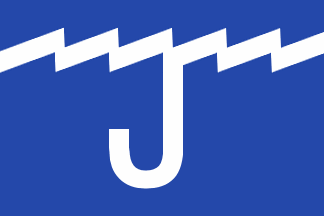 image by Eugene Ipavec, 13 Nov 2007
image by Eugene Ipavec, 13 Nov 2007
On the pages of the Dutch Kombuispraat ("galley talk") discussion site (http://www.kombuispraat.com/viewtopic.dnv?t=911&highlight=maatschappijvlaggen)
there is information about the house flag of a short-lived South African
shipping company:
See the 15 October 2005 and a contribution by "Akwanaut", source unknown (extract
titled 'Bijlage 2: De rederijvlag' i.e. "Annex 2: The house flag), concerning
the various house flags belonging to, or related to, the Java China Japan Line
(NL) :
The right flag of the second row is “ blue with large white initial 'J'
connected to a white stylized wave above it (or, Jupiter-like, descending from a
cloud formation?) with the caption: "Jupiter Lines (Pty) Ltd., Durban
1974-1976".
More is gained from the Ships List site (http://www.theshipslist.com/ships/lines/java.htm)
as follows:
"Also a joint venture was started with the South African Marine Corporation
named Safocean Pty and in 1974 to avoid flag discrimination, the Jupiter Lines
Pty, a daughter company was started in Durban. The New Holland (ex Randfontein)
was taken over from Nedlloyd but the Australian passengers or tourist market was
too small and the ship was sold to China.
In 1975 all the shipping lines were re-grouped and brought under the Nedlloyd
banner and on 01 May 1977 the Nederlandsche Scheepvaart Unie was restyled
as the Koninklijke Nedlloyd Groep and the KJCPL or RIL lost its name and
disappeared into history."
Eugene Ipavec, 13 Nov 2007
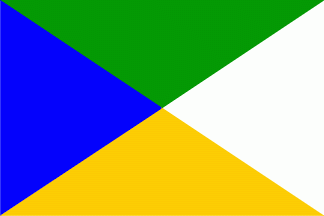 image by Klaus-Michael Schneider, 04 Jan 2014
image by Klaus-Michael Schneider, 04 Jan 2014
The Northern Steam Ship Company and Southern Steam Ship Company
were based in
Johannesburg. Both companies had the same flag
which was divided per saltire into green (top), light orange (bottom), blue (hoist) and white (fly).
Source: Merchant Marine House Flags and Stack
Insignia, US Navy Hydrographic Office (1st edition) 1961, p.3-151.
BBoth companies also have nearly the same flag and funnel as Greek company
Evangelos P. Nomikos. Are there any
connections between them or is it a mere coincidence?
Klaus-Michael Schneider, 04 Jan 2014
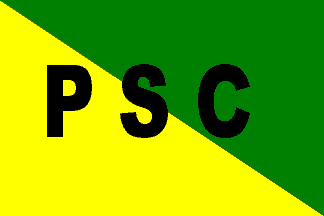 image by
Jarig Bakker, 02 Jan 2005
image by
Jarig Bakker, 02 Jan 2005
From Scott, R.M., The Caltex Book of Flags and Funnels, Cape Town, Caltex
Africa Ltd. (1959) [scx59].
#54 Point Shipping Co., Durban - per fly diagonal green - yellow; black "PSC".
Jarig Bakker, 02 Jan 2005
![[Safmarine houseflag]](../images/z/za~safm.gif) image
by Jorge Candeias, 03 Feb 2002
image
by Jorge Candeias, 03 Feb 2002The Safmarine flag is an orange Scandinavian cross, fimbriated in blue
– since the company was largely Government-owned, it was expected to reflect
the orange, white and blue so beloved of the former National Party government.
Mike Oettle, 03 Feb 2002
The flag is a white swallow tail pennant, divided by a light orange cross
fimbriated blue. The cross is centred (without tails).
Source: Merchant Marine House Flags and Stack Insignia, US Navy
Hydrographic Office (1st edition) 1961.
Klaus-Michael Schneider, 04 Jan 2014
Safmarine Agencies registered a flag on
03 September 1969 with the South
African Bureau of Heraldry with the description: Argent a cross Tenne bordered Azure.
Source: Data
of the Bureau of Heraldry on registered heraldic representations.
Mark Sensen, 19 May 2002
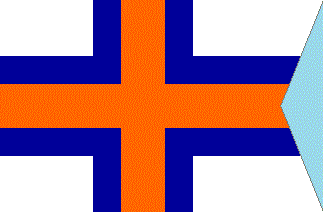 image sent by
Arthur Radburn, 29 May 2015
image sent by
Arthur Radburn, 29 May 2015
An additional item of information : the flag was registered under
the Merchandise Marks Act 1941 in 1947 as protection against unauthorised use (Government
Gazette 3831 (13 June 1947).
As shown in the registration notice, and on the later Bureau of Heraldry
registration certificate, in SAVA Journal SJ: 1/92, and a photo of the
flag in Brian Ingpen's book (1996) 'Safmarine', the flag is rectangular
with a swallow-tailed fly, rather than the tapered flag shown above.
Arthur Radburn, 29 May 2015
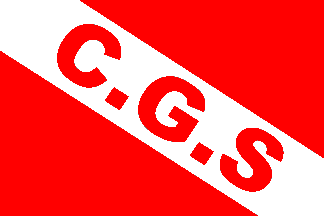 image by
Jarig Bakker, 07 Jan 2005
image by
Jarig Bakker, 07 Jan 2005
From Scott, R.M., The Caltex Book of Flags and Funnels, Cape Town,
Caltex Africa Ltd. (1959) [scx59].
#163 Smith's Coasters (Pty.) Ltd., Durban - red flag, white hoist diagonal
charged with red "C.G.S".
Jarig Bakker, 07 Jan 2005
The letters stand for the original owners, C.G. Smith & Co. Ltd.
Neale Rosanoski, 28 Feb 2005
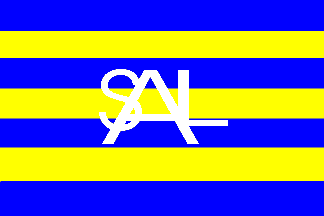 image by
Jarig Bakker, 02 Jan 2005
image by
Jarig Bakker, 02 Jan 2005
From Scott, R.M., The Caltex Book of Flags and Funnels, Cape Town,
Caltex Africa Ltd. (1959) [scx59].
#77 South African Lines, Cape Town - seven horizontal stripes of blue and
yellow; in center white "SAL".
Jarig Bakker, 02 Jan 2005
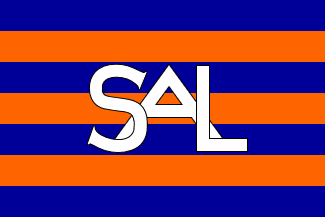 image by Eugene Ipavec, 15 Oct 2011
image by Eugene Ipavec, 15 Oct 2011
I am a former service-engineer of Wilton-Fijenoord Shipyard, which specialized in Doxford ships diesel engines. Since my retirement in 2001 and being the last surviving of the six service-engineers that this yard had employed, I have kept myself busy documenting and writing about merchant marine related subjects that are dear to me, and whereof little can be found in books and other means of publication. From the cap badge it appears that the stripes of the SAL flag are navy blue and orange and not yellow as you illustrate above.
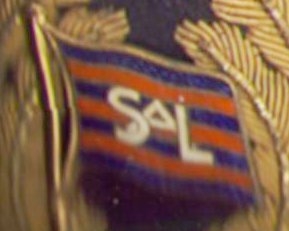 image sent by
Tony van Eijk, 24 Feb 2011
image sent by
Tony van Eijk, 24 Feb 2011
Tony van Eijk, 24 Feb 2011
An open question is whether this should be considered a more accurate
depiction, or whether it's an alternative? We all agree the cap badge
looks more orange, but does anyone have access to the source for the yellow
colour, "Scott, R.M., The Caltex Book of Flags and Funnels, Cape Town, Caltex
Africa Ltd. (1959) [scx59]?"
Peter Hans van den Muijzenberg, 24 Feb 2011
As to the colours, see
Maritime
Timetable Images which shows dark blue & orange stripes and a white
monogram.
Jan Mertens, 25 Feb 2011
As opposed to the yellow of the Deutsche Ost-Afrika-Linie. So in 1967,
and according to the Deutsche Ost-Afrika-Linie, the SAL flag was using orange.
Yet, according to R.M. Scott [scx59]
the flag had "seven horizontal stripes of blue and yellow; in center white
"SAL". I have seen this version used on other web sites as well.
Globus Rheederei (Hamburg) bought SAL
around 1958. If they changed the flag, that would explain the difference. I
wouldn't know whether they did, though.
Peter Hans van den Muijzenberg, 25 Feb 2011
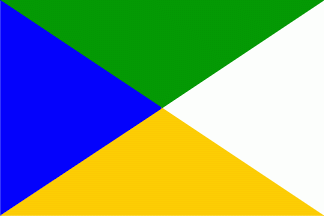 image by Klaus-Michael Schneider, 04 Jan 2014
image by Klaus-Michael Schneider, 04 Jan 2014
The Southern Steam Ship Company and Northern Steam Ship Company
were based in
Johannesburg. Both companies had the same flag
which was divided per saltire into green (top), light orange (bottom), blue (hoist) and white (fly).
Source: Merchant Marine House Flags and Stack
Insignia, US Navy Hydrographic Office (1st edition) 1961, p.3-151.
Both companies also have nearly the same flag and funnel as Greek company
Evangelos P. Nomikos. Are there any
connections between them or is it a mere coincidence?
Klaus-Michael Schneider, 04 Jan 2014
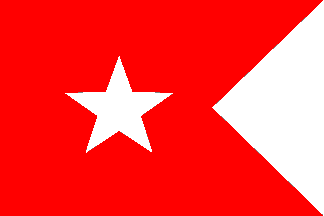 image by Jarig Bakker, 01 Sept 2004
image by Jarig Bakker, 01 Sept 2004
From the link provided by Barbara Tomlinson of
The National Maritime Museum: "The house flag of Thesen's Steam Ship
Co. Ltd, Cape Town. The flag is a
red swallow-tailed burgee with a five-pointed white star. The flag is made of a
wool and synthetic fibre bunting. It has a cotton hoist."
Jarig Bakker, 01 Sept 2004
From Scott, R.M., The Caltex Book of Flags and Funnels, Cape Town,
Caltex Africa Ltd. (1959) [scx59].
#94 Thesen's Steamship Co. Ltd, Cape Town - red swallow tail, white 5-pointed star.
Jarig Bakker, 04 Jan 2005
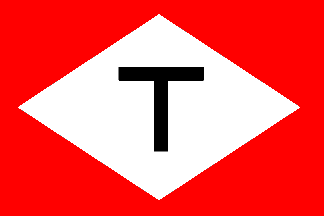 image by Jarig Bakker, 07 Jan 2005
image by Jarig Bakker, 07 Jan 2005
From Scott, R.M., The Caltex Book of Flags and Funnels, Cape Town,
Caltex Africa Ltd. (1959) [scx59].
#165 Tristan Development Corporation, Cape Town - red flag, white diamond, black
"T".
Jarig Bakker, 07 Jan 2005
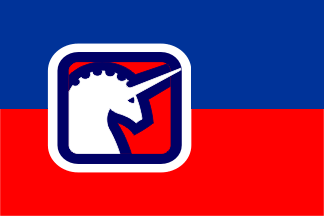 image by Martin Grieve, 27 Sept 2009
image by Martin Grieve, 27 Sept 2009
I have noted with interest the flag shown on your website as that of Unicorn Lines. I can say with some authority as a staff member involved with the revision of the company logo, and subsequently as a Director of Unicorn Lines, that the flag you show is incorrect.
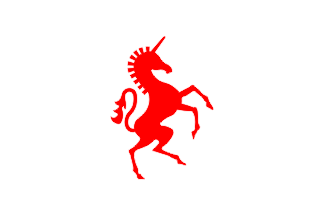 image by Martin Grieve, 27 Sept 2009
image by Martin Grieve, 27 Sept 2009
The logo which was initially adopted by Unicorn Lines in the mid-1960s was a
rampant red unicorn, in profile, facing right. The entire "animal" was depicted,
and not merely the head. This logo was based on the logo of Union Corporation, a
Johannesburg Sock Exchange mining and industrial conglomerate which had a
substantial interest in Unicorn Lines.
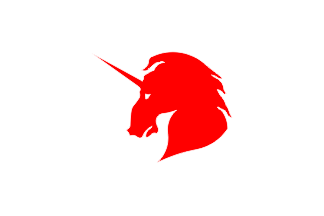 image by Martin Grieve, 27 Sept 2009
image by Martin Grieve, 27 Sept 2009
In the early 1970s the logo was revised. I attach a JPEG file containing a scan
of a Unicorn Lines desk-top flag which Unicorn distributed to its Clients for
many years. As you can see the logo consists only of the stylized head, which
itself it is substantially different from that reflected in your website (see
original article below).
The new logo was incorporated into company letterheads and other documentation
and also appeared on ship's funnels, containers, buildings, vehicles, etc.
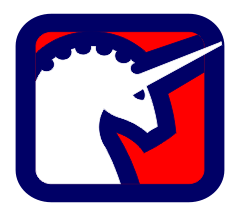 image by Martin Grieve, 27 Sept 2009
image by Martin Grieve, 27 Sept 2009
Unicorn Lines ceased trading under that name several
years ago. However the format of the logo/flag which I have attached continues
to be used in a somewhat modified form by certain Divisions or Departments of
Unicorn Shipping. This may be verified by looking up in the Grindrod Limited
website.
Syd Oram, 16 Sept 2009
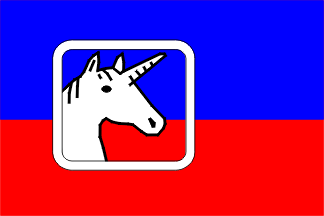 image by Jarig Bakker, 29 Dec 2005
image by Jarig Bakker, 29 Dec 2005Unicorn Lines (Pty), Ltd.,
Durban
has horizontal blue over
red flag; in center white outlined rounded square, charged with a white
unicorn's head in the centre.
Image after Brown's Flags and Funnels of Shipping Companies of the
World, compiled by J.L. Loughran, Glasgow, 1995.
Jarig Bakker, 29 Dec 2005
Union Steam Ship Company of South Africa Ltd.
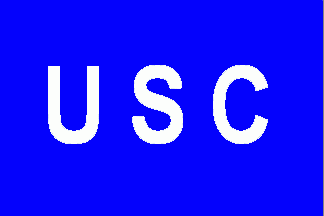 image by Klaus-Michael Schneider, 04 Jan 2014
image by Klaus-Michael Schneider, 04 Jan 2014
The company is located in Cape Town. Their flag is blue with white, unserifed
initials “USC”.
Source: Merchant Marine House Flags and Stack
Insigni, US Navy Hydrographic Office:1st edition (1961) p.3-151.
Klaus-Michael Schneider, 04 Jan 2014
"Union Steam Ship Company of South Africa" was originally the name sometimes
used, especially in New Zealand, for the
Union Steamship Company, which sailed between
Southampton (United Kingdom) and Cape Town. This served to distinguish
that company from the Union Steam Ship Company, based in New Zealand. For the same reason the latter was often
indicated as "Union Steam Ship Company of New Zealand".
However, it appears that in the middle of the 20th century, some time after the
Union Steamship Company merged with the Castle Line, a different "Union Steam
Ship Company of South Africa" existed, owned by Coast Lines Africa Pty Ltd.. The
earliest mention I came across is 1946 and the last was in 1968. (It would
appear Coast Lines Africa was at some point acquired by P&O).
Peter Hans van den Muijzenberg, 17 Jan 2014